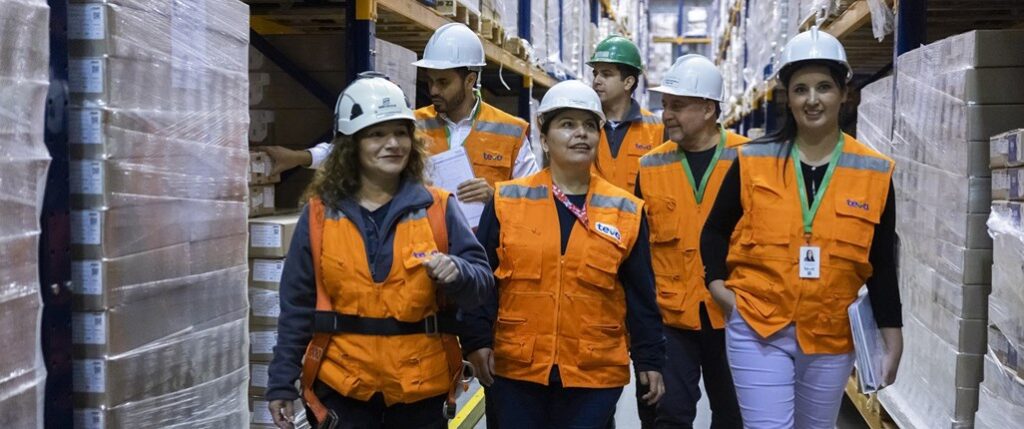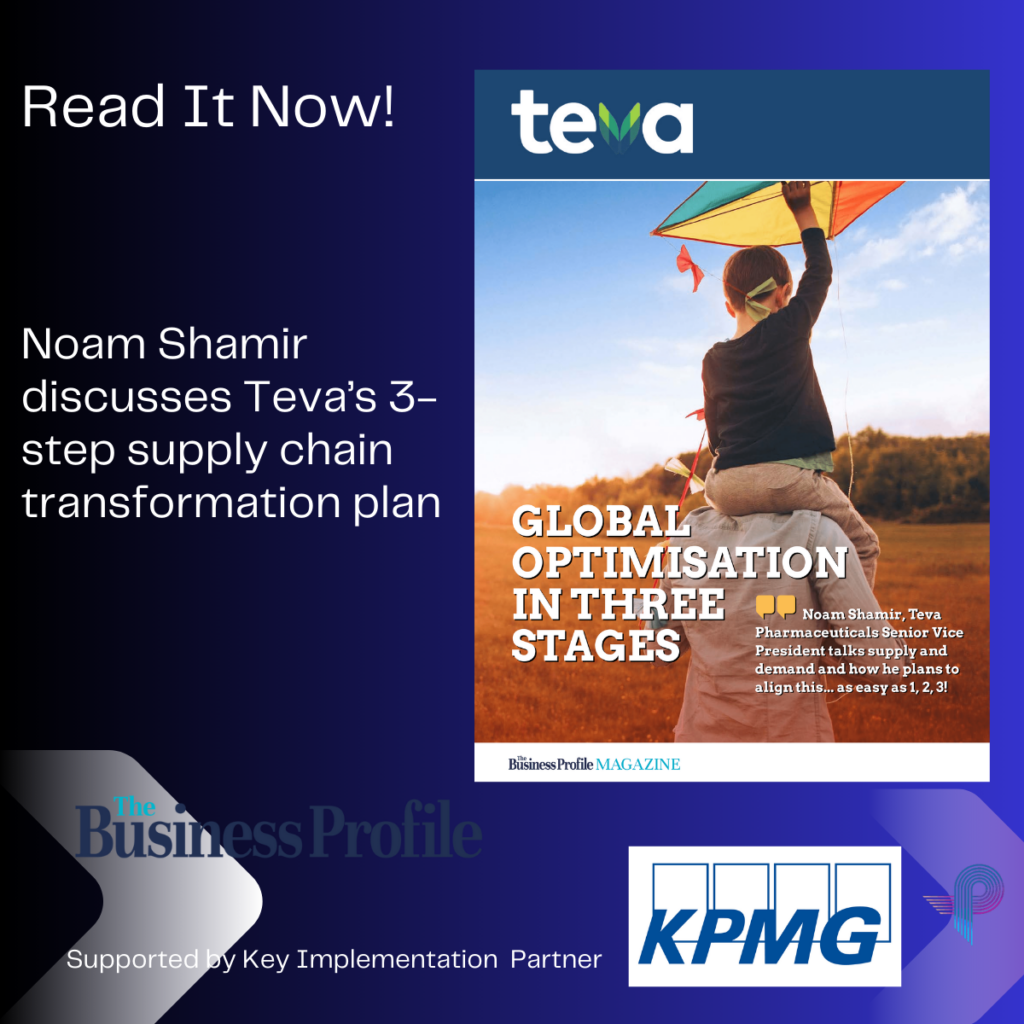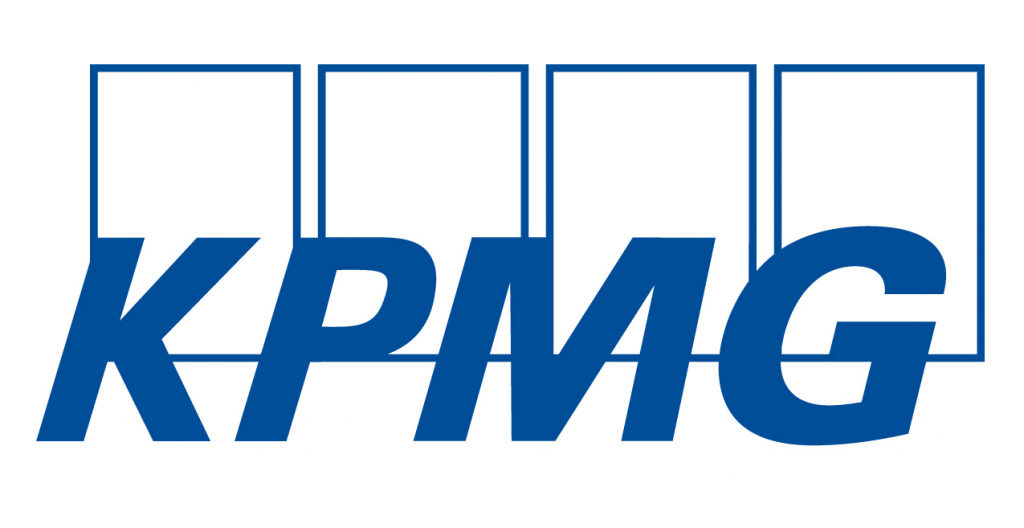Teva Pharmaceuticals is undergoing a three-stage supply chain transformation under the guidance of Noam Shamir, the company’s soon-retiring Senior Vice President for Global Supply Chain. After “fixing the foundations”, attentions have turned to more expansive and innovative ways to align supply and demand across a truly global operation.
Hi Noam. Working as Senior Vice President for Global Supply Chain at any company would be a challenge. However, when the company in question is as ‘global’ as yours, the challenge is even greater. Please introduce us to this role and responsibility…
My responsibility is, simply, to align supply and demand. But, as you say, this implicates 60 manufacturing sites and 60 markets around the globe. It’s a ‘many to many’ interface where many sites are supplying many different markets. And of course, this management and aligning of supply and demand must be done while optimizing the working capital of the company – the cash flow of the company – to make sure we’re providing the right product at the right cost at the right time, and at the right quality.
The complexity doesn’t stop there, though.
Traditionally, Teva is a company that has grown through mergers and acquisitions, with the latter the most familiar route. Through this approach, we have ended up with many, many different ERPs – a very diverse system with more than 20 different ERPs, which naturally works against the idea of optimising the end-to-end supply chain.
So, three years ago when I began my current role, we initiated a refresh of our supply chain strategy, with the main aim of having an end-to-end, concurrent, real-time solution to align supply and demand through one system.
Click Below: view the digital brochure version of this content
Given the infrastructure you described, where did you even begin with this refresh?
Well, indeed, we realised that we had major gaps and there were things we had to do to fix our foundations first before moving to the next stage. First, we established that we wanted to use SAP’s Advanced Planning Optimizer as our basic tool, and made sure this was deployed as standard across our 60 sites. This standard set out how to use the system, what planning parameters to use, and how we should be working as a whole organisation. So, we had a standard way of planning our supply at that point.
Naturally, there is no “one solution fits all” to our diverse portfolio so we applied a segmented approach where products are planned based on their criticality to the business (ABC), and the volatility of their supply and demand patterns.
The segmented approach enabled minimal risk to the business with minimal working capital impact.
We also extended our planning parameters. Until then, we had a constrained planning horizon of four months, and the next four months beyond that was unconstrained. We wanted to extend the planning horizon to two years to better anticipate the capacity, headcount, and capex investments needed. Of course, this brings better visibility.
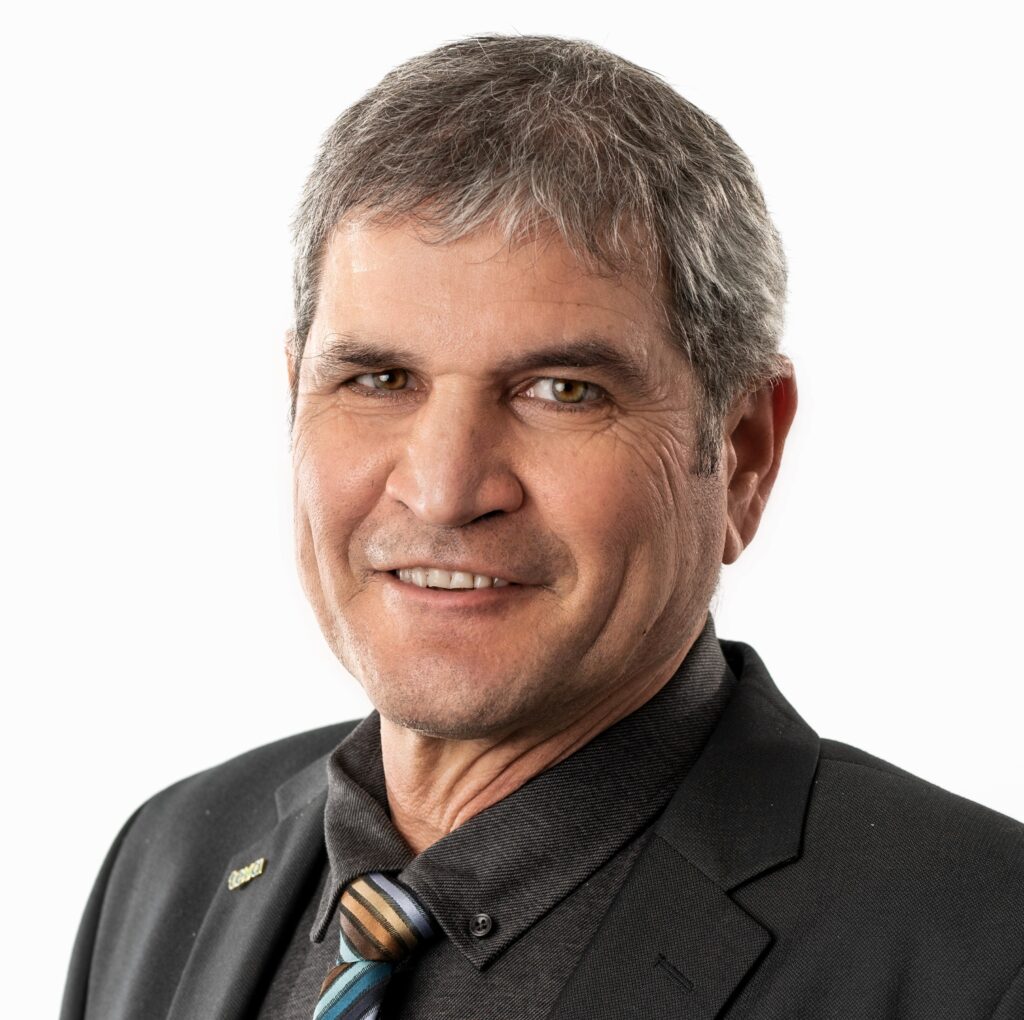
Another element is that we improved our demand sensing by introducing artificial intelligence and machine learning as part of our focused initiative. This was a very successful initiative where we were able to significantly improve the demand signals that we got from the market, which is of course essential to make sure that we have good supply.
And the final element in terms of fixing the foundations was addressing human capability. We’ve worked really hard on upskilling our people to make sure they are prepared for this digitisation effort. This included courses for planners, a planners’ academy, a special programme for supply chain leaders and project management. We really worked very hard on people engagement and making sure that people understand what the strategy is, and what they need to be able to do to help us in meeting that strategy’s objectives.
How long did all of this take?
This all took around two years, the ‘fixing the foundations’ stage. We’re technically still working on it as improvement needs to be continuous, but we have now reached a level where we can begin the second stage of our plan.
And what does stage two comprise?
So here, the focus is on integrated business planning (IBP), end-to-end. We have deployed SAP IBP as our planning tool, and we’ve done this after developing an operating model where we asked ourselves: ‘what is the standard way Teva is doing supply chain planning?’
Another element in this stage is the end-to-end collaborative planning, extending our connectivity both upstream and downstream. Upstream meaning our vendors – making sure we have a digitised connection with them with the right level of transparency. And then of course, downstream, to our customers. This stage is ongoing as we continue to explore and deploy several tools that will allow this to happen, with a view to ending that stage some time in 2025.
Implementation Partner and Content Sponsor: KPMG
KPMG integrates acquired knowledge, experience with leading life sciences companies and best business practices into the comprehensive program, having refined the implementation approach through past experiences – Delivering comprehensive IBP expertise and implementation methodology
Dare I ask then… is there a stage three?
Absolutely! A stage three will follow straight after. And this is really about the modernisation and complete digitalisation of our supply chain. By this, I mean exploring and embedding new technologies such as machine learning, the internet of things, blockchain and many others, to make sure we have the most sophisticated tool suite possible.
All of this will be supported by an extended control tower that allows that end-to-end visibility and management.
As a high-level overview of this future, this is the kind of ecosystem we’re trying to build. We’ve made very nice progress so far, and can already see from the middle of the second phase how these changes are benefitting us. Every aspect of our supply chain performance, our service, our efficiency, our customer effectiveness, our inventory positioning and our overall customer proposition has been improved. It’s been fantastic so far!
You’ve covered quite a broad time period there in terms of the overarching transformation plans. Just to take you back to the start of this process, though – what were the main challenges or bottlenecks that triggered such comprehensive steps to be taken?
Well firstly, it was a very challenging period of course, and not just because of COVID. The macroeconomic and geopolitical landscape had huge impacts on everyone’s supply chains – experts have called it the biggest disruption since World War Two, and probably for a reason.
The ripple effects touched all parts of the operation. Recruiting people, sourcing raw materials, managing logistics… and then, in pharmaceuticals, the direct impacts of COVID were also very stern in our space.
The headwinds really exposed shortfalls we had in terms of transparency, disconnections between systems, the issues of siloes, and so on.
For the IBP implementation we chose KPMG to be our partner.
Noam Shamir
The profound understanding of corporate financial ,specifically on SAP environment with vast experience in change management was key for successful implementation and helped us to avoid critical mistakes
What made you turn to SAP specifically to help guide the transformative first steps?
We have long had a strategic partnership with SAP, so it was always a priority to see what they could deliver for us.
Specifically, we found the IBP and the S/4HANA to be effective solutions, complemented by an external solution that we adopted for detailed scheduling. This was where we incorporated Microsoft Azure into our SAP environment.
In each case, it was my responsibility to show to the ultimate decision makers and boardroom, the challenges of working in siloes and how that impacted our working capital. I received such good support from our CFO in particular, which is really important. They quickly understood what we were trying to achieve and helped convey the right message. Ultimately, this clarity and alignment of what we needed has helped to speed up deployment.
That makes sense, given the amount achieved in a relatively short space of time…
Exactly. I’ve even been surprised by how well the whole strategy has been adopted and driven by people outside of supply chain. They can see the advantages, are willing to explore tools we’ve never tried before and can see what a real-time, end-to-end solution would do from an optimisation perspective.
There will always be difficulties along the way but when everyone is agreed on the bigger picture and the direction we want to head, then people also get encouraged by the wins along the way – the feedback from customers and vendors.
This points to a cultural transformation as much as a digital one?
Absolutely. We used to have supply chain planning and financial planning and commercial planning, and they weren’t always aligned. Now, with one system and one set of numbers we’re speaking the same language and decisions are made much more quickly.
And that filters to the customer too. When you’re reducing huge amounts of inventory and start doing much more with fewer corporate resources, they ultimately see the results of that efficiency just like we do.
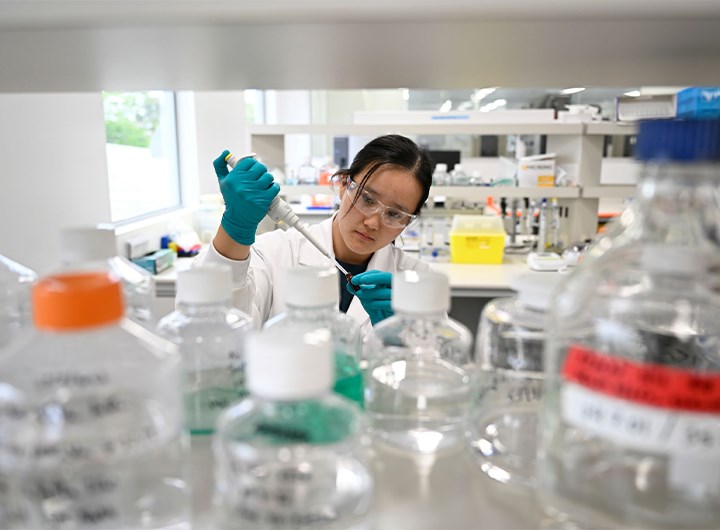
According to our own metrics, our customer service level has improved by 2.5 points to 97.5 percent, we have reduced almost 30 days on hand in terms of inventory, as well as reducing almost half a billion dollars in our write-off.
Compare that to where we were in 2020, despite the headwinds we discussed, and the argument for change is very clear.
One aspect we haven’t discussed that I know is important, is sustainability…
For sure, this is so significant in everything we’ve been doing. Teva was the first pharma company to issue sustainability-linked bonds – bonds that are actually linked to sustainability performance.
Our ambitious goals were to reduce our scope one and two emissions by 50 percent by the end of the decade, while still improving the accessibility of our drugs to more people. In the supply chain specifically, we want to reduce our CO2 emissions by using electric trucks and trains instead of air shipments, while also being far more efficient with the packaging of our products to be more efficient in transportation.
A global company that has grown through acquisitions, as we said at the start, has a more complex supply chain than most. Adding to that complexity, is there also a responsibility to lead by example in your ecosystem, especially when it comes to things like sustainability?
Absolutely! Our emissions aren’t just reliant on what we’re doing. They also include the ecosystem around us, and partners who maybe don’t have the resources to make quick changes like we do. It’s complicated, but it’s important to measure our sustainability success as a complete activity, and for that we also need to bring our ecosystem with us on the journey.
When it comes to companies that we have acquired, it’s also important to have the standards we now have in place to ensure a quick and seamless integration to our system and our way of working.
So, looking ahead – you’re in the middle of stage two with eyes firmly set on stage three. If we were to speak again this time next year, what would you hope and expect to have achieved?
We have several systems that we are either deploying as we speak or looking into for the coming months. To mention a few, I should start with the focus on demand sensing and harnessing machine learning to better understand true demand. This wouldn’t just be based on internal data but also on weather forecasts, air pollution forecasts and a host of additional external factors which impact a global operation.
We’re also looking into decision automation and how AI can help us there. This could mean tweaking our planning parameters, and will work in conjunction with a digital twin to carry out scenario-based analysis of future opportunities or challenges. To carry out different possibilities through a computer simulation helps with risk identification and management. We want to be able to quickly identify possible issues ahead of time and then plot the best way forward.
We are also looking into integrating our logistics planning. So, using smart cards that have GPS and internet of things capability on them, that will enable us to monitor where our goods are around the globe, and what condition they are being exposed to.
We are also looking into incorporating blockchain capabilities into our supply chain security.
These are the main elements that we want to add in order to digitalise our supply chain. The vision is to have a control tower built of all these elements and all of this interconnected information, giving us the best possible visibility of supply and demand factors.
Having been at the heart of a comprehensive supply chain transformation for the past three years, at such a large company, what would your advice be for others considering whether it’s worth the complexity? Or indeed, where they should start?
The supply chain really is all about collaborative integration of supply and demand. If you’re a global company, this means taking a global optimisation approach, rather than a local one. People don’t realise that just because every local node in your network is optimised, it doesn’t mean that the whole network is. If they are independent then there will still be challenges, and actually, the different nodes would usually have to work in a suboptimal way in order to help the whole network run as well as it can in that scenario. Optimising each node individually, comes at the expense of another.
For us, having a clear vision and looking at our entire supply chain, end-to-end, and making sure we are using corporate resources in the best way, holistically, has been our differentiator and has set the foundations for more progress to come.

